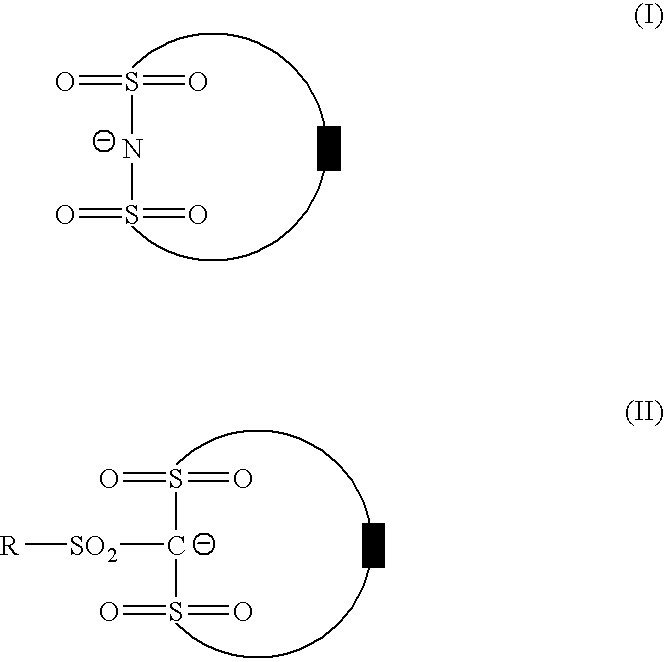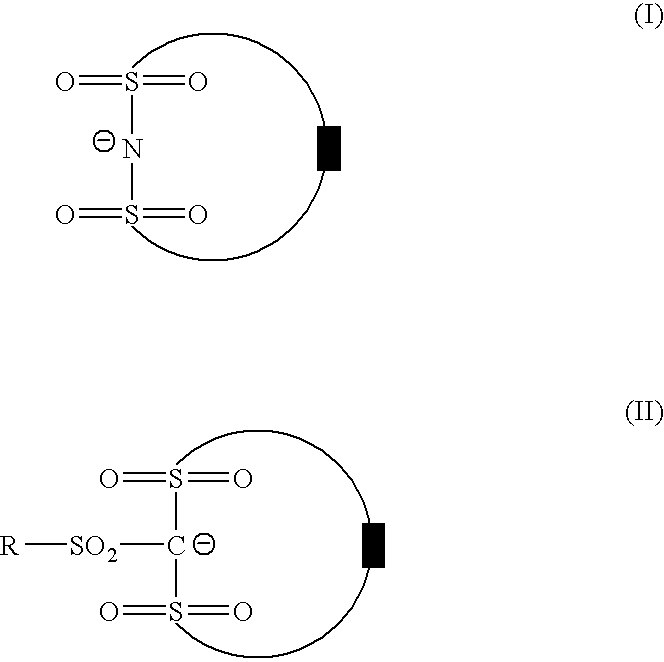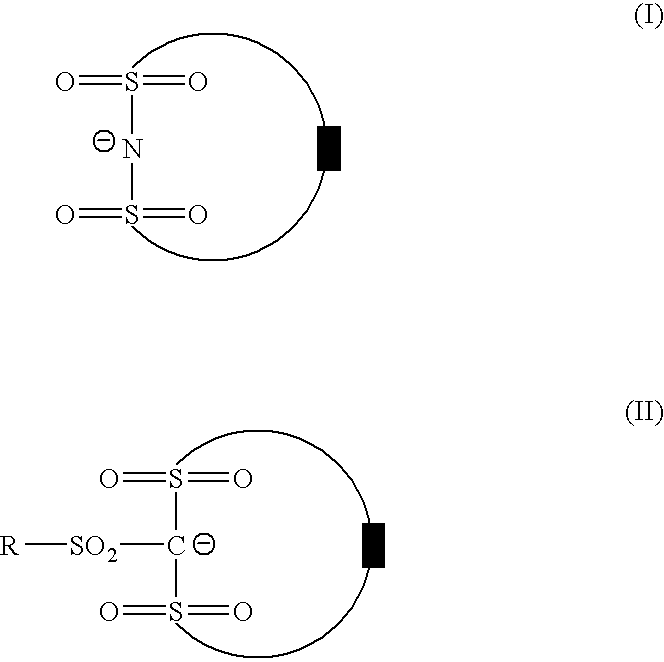Photosensitive composition and pattern-forming method using the photosensitive composition
a composition and composition technology, applied in the field of photosensitive composition and pattern-forming method using the photosensitive composition, can solve the problems of insufficient chemical amplified resists and insufficient compounds
- Summary
- Abstract
- Description
- Claims
- Application Information
AI Technical Summary
Benefits of technology
Problems solved by technology
Method used
Image
Examples
synthesis example 1
Synthesis of Compound (I-1)
[0391] Triphenylsulfonium iodide (3.3 g) was dissolved in acetonitrile / distilled water (2 / 1, by mass), 1.5 g of silver acetate was added to the above solution, and the solution was stirred for 30 minutes. The precipitated silver compound was filtered, and 3.0 g of the following shown compound (IA) dissolved in acetonitrile / distilled water (2 / 1, by mass) was added to the filtrate. The reaction solution was concentrated, and then dissolved in 200 ml of chloroform. The resulted solution was washed with distilled water, an aqueous solution of ammonium chloride, and water. The organic phase was filtered through a polyfluorotetraethylene filter having a pore diameter of 0.1 μm and concentrated, whereby 4.2 g of compound I-1 was obtained.
[0392]1H-NMR (300 MHz, CHCl3) δ 7.6-7.8 (m. 15H) 19F-NMR (300 MHz, CHCl3) δ 115.59 (4F), δ 122.29 (2F)
synthesis example 2
Synthesis of Compound (I-2)
[0393] 4-Cyclohexylphenyldiphenylsulfonium bromide (2.4 g) was dissolved in acetonitrile, and 2.0 g of compound (IA) was dissolved in acetonitrile and added to the above solution. The reaction solution was filtered, concentrated, and then dissolved in 200 ml of chloroform. The resulted solution was washed with distilled water two times. The organic phase was filtered through a polyfluorotetraethylene filter having a pore diameter of 0.1 μm and concentrated, and then washed with diisopropyl ether / hexane, whereby 2.4 g of compound I-22 was obtained.
[0394]1H-NMR (300 MHz, CHCl3) δ 1.2-2.0 (m. 10H), δ 2.5-2.7 (m. 1H), δ 7.5-7.8 (m. 15H) 19F-NMR (300 MHz, CHCl3) δ 115.60 (4F), δ 122.30 (2F)
[0395] Other acid generating agents were also synthesized in the similar manner.
Resin (B):
[0396] The structure and molecular weight of each resin (B) used in Examples are shown below.
MolecularWeight (1)10700 (2)9400 (4)10300 (6)11300 (7)8900(11)13400(15)9600(16)5800(1...
examples ar 1
TO Ar 22 AND COMPARATIVE EXAMPLE ar 1
Preparation of Resist:
[0399] The components shown in Table 2 below were dissolved in a solvent to prepare a solution having solids concentration of 12 mass %, and the solution was filtered through a polytetrafluoroethylene filter having a pore diameter of 0.1 μm, whereby a positive resist solution was prepared. The prepared positive resist solution was evaluated by the method described below. The results of evaluation are shown in Table 2 below.
TABLE 2CompositionEvaluationAcidLine Width ofGeneratingCritical(A) AcidAgent UsedPattern collapseGeneratingin(B)Basic(nm)AgentCombinationResinCompoundSurfactantSolventDenseLoneExample(g)(g)(10 g)(g)(g)(by mass)PatternPatternAr 1I-1 (0.3)— (1)DIA (0.03)W-4 (0.01)A1 / B1 = 70 / 309583Ar 2I-1 (0.4)z43 (0.4) (4)TPA (0.03)W-2 (0.02)A1 / A3 = 40 / 609681Ar 3I-2 (0.2)z6 (0.2) (6)HAP (0.02)W-1 (0.01)A1 / B1 = 50 / 509280Ar 4I-6 (0.3)z8 (0.1) (6)DIA (0.03)W-4 (0.01)A1 / B1 = 60 / 409481Ar 5I-1 (0.4)z12 (0.05) (7)PEA (0.01)W-4 ...
PUM
| Property | Measurement | Unit |
|---|---|---|
| temperature | aaaaa | aaaaa |
| temperature | aaaaa | aaaaa |
| temperature | aaaaa | aaaaa |
Abstract
Description
Claims
Application Information
 Login to View More
Login to View More - R&D
- Intellectual Property
- Life Sciences
- Materials
- Tech Scout
- Unparalleled Data Quality
- Higher Quality Content
- 60% Fewer Hallucinations
Browse by: Latest US Patents, China's latest patents, Technical Efficacy Thesaurus, Application Domain, Technology Topic, Popular Technical Reports.
© 2025 PatSnap. All rights reserved.Legal|Privacy policy|Modern Slavery Act Transparency Statement|Sitemap|About US| Contact US: help@patsnap.com



